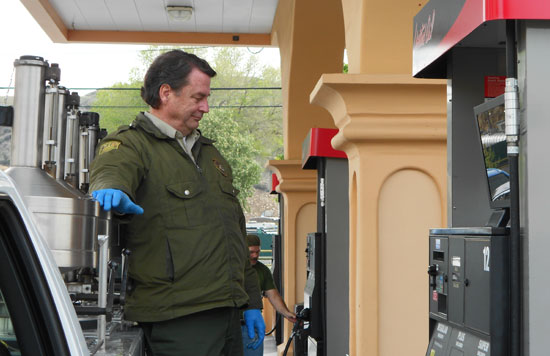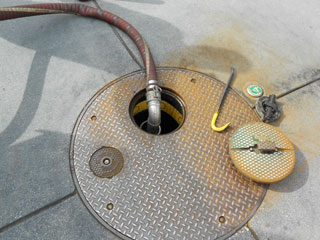A measure of good news?
March 29, 2012

L.A. County inspector Mark Smith says 94% of pumps are accurate, with mistakes often favoring consumers.
The price of gas may not be particularly reassuring, but Mark Smith may have some comforting news.
An inspector with the Los Angeles County Bureau of Weights and Measures, Smith is part of a 13-person unit that monitors the county’s 55,000-plus gas pumps. His mission? To make sure beleaguered consumers get what they pay for at the gas pump. His message? Ninety-four percent of the time, they do.
“When the price of gas is real high, like it is now, people ask me about four times a day if the gas pumps are in compliance,” said Smith, pulling up to a bank of pumps at a United Oil station in Santa Clarita on a recent morning. The sun gleamed on the aluminum tanks of his specialized testing truck. Around him, glum-looking motorists stood, filling their tanks and averting their eyes from the gas meters as the dollars flew by.
“This has gotta be wrong!” exclaimed Santiago Cardenas from the next pump as his mid-sized Mazda SUV guzzled gallon after gallon. “I notice the needle is at not more than half the tank and it’s already at $55!”
“When gas prices spike, usually so do consumer complaints,” Smith noted. “People say, ‘I know my tank holds 20 gallons and I just pumped 21,’ or ‘I just put six gallons in a 5-gallon can—I’m being shorted.”
In fact, Smith explained to Cardenas, owners’ manuals and gas gauges are notoriously inexact when it comes to conveying the precise capacity of a gas tank.
“If your owner’s manual says 20 gallons, you can probably put as much as 22 in it, and if your gauge says a half or a quarter of a tank, you could have anything around there. I’ve been on hundreds of complaints like that and they’re almost never valid,” Smith said.
Smith and his colleagues operate as a sort of team of “gas busters” for haunted consumers who often drive away from the pump wishing they knew whom to call for relief. Each year, the team checks each grade of fuel at each pump at each of the county’s 1,900-plus gas stations; inspectors also investigate every complaint received by the department, usually within hours.
“We had, like, a 150 percent increase in complaints earlier this year when the price of gas went way up,” said Laurence Nolan, who heads the bureau. In less stressful times, Nolan said, the bureau averages about 500 complaints annually.
Though an inspection involves scores of issues, from equipment to handicapped signage, the pumps are subjected to a fairly straightforward test: A pickup truck equipped with four 5-gallon measuring devices—one for each of the usual grades of gasoline and one for diesel—is pulled up next to the tank. Then five gallons are pumped into each receptacle to see if the pump’s measurements and the county’s match.
If the reading is off by more than 6 cubic inches, or about 3 ounces, the owner is cited and given 30 days to fix the problem. If the error is in the consumer’s favor, the station can decide whether to let the pump continue operating, but if the consumer is being shorted, the county shuts down the pump until it’s repaired.
Fines range from about $150 to $600 per violation, depending on whether the station owner is a repeat offender, said Nolan. After the test, the gas collected by the inspector is drained back into the station’s underground tanks.
Over the years, scams occasionally have been uncovered. In 1999, for instance, a gas station owner and his brother pleaded guilty to felony conspiracy charges after they were caught outfitting pumps at a dozen Southern California Mepco stations with computer chips that generated fraudulent readings.
And last year, a West Covina gas station owner was charged with false advertising after he repeatedly removed parts of the price numbers from his double-sided price signs, leading motorists to believe he charged less than a neighboring gas station.
But the vast majority of station owners are honest, Smith and Noland said, and the pumps are usually accurate to within a couple of teaspoons per gallon. The most common problems involve meters that either start registering a purchase before the consumer starts pumping, or continue running after the consumer stops pumping—“jump” and “creep”, in gas pump parlance. Both generally stem from faulty hoses and nozzles and are easily fixed, Smith said.
“Only about 6 percent of the pumps we check have to be tagged for being out of compliance,” said Nolan. And, he added, the majority of those violations are either borderline or in the consumer’s favor. At that Santa Clarita gas station, for instance, only one pump out of 38 was off-kilter—and it was dispensing too much gas.
“The owners here are losing about four cents a gallon,” Smith observed, adding that consumers also often believe, inaccurately, that station owners are getting rich from the gas crunch.
“Mostly what I hear from station owners is that they can’t believe they’re still in business, they’re making so little profit,” Smith said. “Especially the mom-and-pops. It’s tough out there.”
Still, every penny matters, and Smith does have some advice for consumers.
“When you authorize the pump, look at it for five seconds before you start pumping. See whether the reading jumps. And when you’re done pumping, before you hang up the nozzle, watch again to see whether it creeps up.
“If it does, tell the attendant, tell them what happened and they should refund your money or reauthorize it so you don’t get charged for it.”
If your concern isn’t satisfactorily handled, or you still feel overcharged, you can contact the bureau toll-free at 800 665 2900 or write them at Los Angeles County Agricultural Commissioner/ Weights & Measures Bureau, 11012 Garfield Ave. , South Gate, CA 90280. Or complete an online complaint form here.
Posted 3/29/12













 405 bridge work causes a stink
405 bridge work causes a stink
